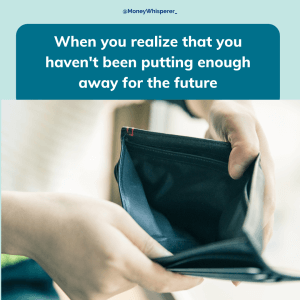This post may contain affiliate links which means that if you click through to a product or service and then buy it, I receive a small commission. There is no additional charge to you.
If there were a visual representation of ‘retirement’, what would it include?
Happy pensioners exploring the world on cruise ships? Maybe trying their hand at new hobbies which they haven’t previously had time for? Spending more time with loved ones?

Can you picture your own lifestyle in retirement?
Given the travel restrictions of the last 18 months, it is hardly surprising that getting on a plane and escaping is front of mind for many. The latest Great British Retirement Survey (GBRS) shows that one in three of the 10,000 respondents consider travel as their top priority when they stop working.
But it’s not all sunshine and pina coladas; the top financial worries for those already retired are the value of shares declining (47%), the rising cost of living (34%) and the risk of running out of money in retirement (27%).
These worries are even higher among the not-yet-retired respondents (49%, 42% and 41% respectively). Younger folk are well aware that they are going to be footing the bill for the COVID recovery measures for a considerable chunk of their working lives. Is this going to make saving for the future more difficult? Are we going to be able to retire like we used to?
Now versus later
For those for whom retirement is still a way off, it can be difficult to contemplate in any detail what life looks like in this stage of later life. We’re naturally biased towards living in the present and think about our short term plans more readily than those which are years off.
When it comes to our financial behaviour, recent research by the Pensions and Lifetime Savings Association shows that 51% of people focus on their current needs and wants at the expense of stashing away money now to enable them to have the retirement lifestyle that they want.
The younger respondents of the GBRS were indeed focused more on short term goals such as home ownership than on their longer term plans into retirement.
But this younger generation no longer has the luxury of gold-plated workplace defined benefit pension schemes which will provide for them until the end of their days. The reality is that if we don’t turn our minds to what life in the future looks like, it probably won’t turn out quite as we hope. We need to be giving proper attention to our retirement plans now.
What’s it going to cost?
The Pensions and Lifetime Savings Association published the ‘Retirement Living Standards’ this week. These standards give an idea of how much money is needed annually to sustain different levels of lifestyle.
Detailed are three different standards of living – minimum, moderate and comfortable – with a basket of goods and associated costs for each, made up of household bills, food and drink, transport, holidays and leisure, clothing and personal care, and helping others.
- The Minimum Lifestyle covers basic needs plus some ‘fun money’ which could be used for a week’s holiday in the UK, a once a month treat of eating out and ‘affordable’ leisure activities twice a week. (Although there is no budget factored in for a car to enable you to drive yourself to any of these!).
- The Comfortable Lifestyle allows for a subscription to a streaming service, regular beauty treatments and two foreign holidays a year.
- The Moderate Lifestyle sits somewhere in between the two, with one foreign holiday a year and eating out a few times a month.
Roughly speaking, a single person will need about £11k a year to achieve the minimum living standard, £21k a year for moderate, and £34k a year for comfortable. For couples, it’s £17k, £31k and £50k respectively.
Importantly, these standards do not include an allowance for mortgage or rent. The idea that people are mortgage or rent-free by the time they retire may have been true for past generations, but how realistic is it now?
According to the ONS, whilst home ownership among over-65s has been rising in England, around 4% still have a mortgage and 21% are renting. Worryingly, 29% of retired GBRS respondents who were renting said their pensions were insufficient to cover rent payments and other living expenses.
Is the issue going to become greater for ‘Generation Rent’ who simply can’t afford to get on to the housing ladder because of rising house prices and deposit demands? Younger people now are less likely to own a home than in the past, and people in their mid-thirties to mid-forties are three times more likely to rent than 20 years ago.
If continued costs of renting into retirement are added to these retirement standard estimates, the retirement savings goal posts increase significantly.
Retiring from paid work but with the continued worry of paying out considerable sums to keep a roof over your head may become a scary prospect for many. Among renters who were not yet retired, 32% said their pensions would not be enough to cover rent payments and other living expenses, and 38% were not sure.
But we have the state pension to save us, right?
For those in receipt of the full state pension, which in 2021-22 is £9,339 per year, this goes a long way to reaching the minimum Retirement Living Standard. The gap can be bridged by other retirement savings including workplace pension savings, SIPPS, ISAs, buy to let income.
However, many non-retired respondents to the GBRS simply don’t believe that the state pension will exist for them by the time that they reach state pension retirement age, with uncertainty highest in the 24 to 29 age group at 53%.
Moira O’Neill, Head of Personal Finance at interactive investor says: “It’s a measure of how little people trust the government around pensions that younger respondents are questioning whether they’ll even get a state pension. And this comes at the same time as they’re finding it harder than ever to start the journey of home ownership”.
My personal thoughts on the state pension as the kickstarter for my retirement pot is that it will be a nice bonus if it is still around. But I am certainly not banking on it. With government policy always at risk of change, the only way we can truly be able to support ourselves in old age is to make sure we are not reliant on the state pension.

Worried about how little thought you’ve given you retirement?
So if you’ve read all this and know you haven’t paid enough attention to ‘future you’ and your retirement plans, don’t beat yourself up.
Get clued up on your options
It’s clear from the ii poll that pensions still dominate retirement plans; 65% of retired and 60% of non-retired respondents said pensions were their most important source of retirement income. But half of respondents also had stocks and shares ISAs, and one in five had buy to let investments.
Personal finance is very personal and what’s right for one person isn’t necessarily right for another. Understanding the different tax implications of each asset class is an important part of your investment strategy, so do your research and educate yourself around the pros and cons of each. And remember, like anything investing related, having fingers in different pots is typically never a bad thing.
Get clear on what you have accumulated, and track your progress
Keeping track of our progress towards goals on our financial journey should be like weighing ourselves when we’re on a weight loss journey; you need to keep checking in. Not only does it help you monitor progress, but the continued progress itself motivates you to keep going towards achievement of the goal.
If you are like many adults who have accumulated multiple pension pots, this can lead to a risk of losing track of them. 15% of non-retired respondents had four or more pension pots and one in 17 (6%) did not know how many pension pots they had, highlighting a significant risk that money which is rightfully theirs could get lost.
Check in with your savings and investments. Fish out your pensions and ISA paperwork and make sure to sign up for online access which avoids paperwork getting lost in the future. If you have lost all the details of old pensions, use the government’s free Pension Tracing Service to find them.
Keeping track quarterly of your net worth is a great practice to get into. Write down the value of everything you own, which might include ISAs, cash savings, property and pensions, less everything that you owe. Remember that your home can’t feed you when you are old so you need a good balance of assets in the mix that can.
Visualise your future
Finally, get to know ‘future you’. If you want to fund the life of your future, you need a picture of what that life looks like. This is what will help you to flesh out how much you need to be aiming for. Whilst the guides are there to help you work out how much you might need, they are only guides. We all have unique situations, aspirations and starting points. I know for sure is that I won’t be happy to settle for a minimum lifestyle with no car and no foreign holidays – and that’s a great incentive to get putting more money away for my own retirement.


